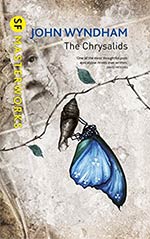
![]() charlesdee
charlesdee
6/10/2012
![]()
Centuries after a nuclear war, one remnant of humanity lives in Labrador, a country transformed by climate change and a theocratic government into England in the late Middle Ages. The setting is an affluent farming community that lives strictly by the laws set out in the Bible and a work called The Repentances. The latter work has set the program for identifying what is in the true image of God, something that could come in handy in a society that still undergoes periods of mutated births and crops. These mutations are especially severe when the wind blows strongly from the south. Southwest lies The Badlands, country so scorched by radiation it remains poisonous. Since this society considers the distant war years The Tribulation and gives a primitive theological interpretation to the effects of radiation poisoning, giving birth to a mutated child is blasphemy and a judgment on the community. They burn crops that show signs of deviation. This helps keeps them healthy. They leave an infant with six toes to die of exposure or be taken in by Fringe Dwellers. This makes them easy for modern readers to judge.
John Strorm's father is successful farmer and leader in the local church. John's friendship with a six-toed girl and her family that hides her sets him on a road to questioning authority. This road is made easier to follow because each night he is in telepathic communication with his cousin who lives on an adjoining farm and a dozen other children, most of whom he has never met. He learns a bit more about the world at large from Uncle Axel who was once a sailor. His voyages have made him something of a cosmopolitan compared to the locals, but when he tells John what he has learned of the world at large, we come up against the poorest elements of Wyndham's writing. Uncle Axel's descriptions of The Fringes, The Badlands, and more distant lands where people have made lives for themselves following different ways than those laid down in The Repentances have all the liveliness of the worst narration found in the worst nature documentaries. But they make their point, something Wyndham seems unable to do without hammering it home to make sure we are getting it.
Many positive reader reviews of The Chrysalids mention reading it as a teenager. Lessons about toleration and questioning authority are always worth hearing, but those learned in adolescence remain the most vivid. For the last third of the novel, I kept telling Wyndham, OK, I get it.
But then he makes some surprising moves. The telepathic children, now young adults, are on the run from the mobs with the torches and the pitchforks -- no, wait, that's a different story. But they are on the run, in danger from both their own families and the not so broadminded Fringe People. They have made contact with an advanced group of telepaths who are flying to their rescue -- yes, flying. They have balloon like vehicles and what turn out to be pretty nasty weaponry. Like all the groups in the novels, they are fighting to protect their place in society, and they are cold blooded when it comes to fighting to the death. I was reminded of Theodore Sturgeon's More Than Human, where those who represent the next step in human evolution are not anyone you would want to cross in real life. Superior beings tend to have a pretty high opinion of themselves.
http://www.potatoweather.blogspot.com